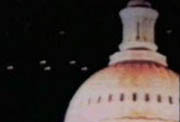UFO: Radar Sightings
Some UFO sightings occur during the day (daylight discs) and some at night (nocturnal lights), but sometimes a UFO is only a blip on the radar—or is it? Extra terrestrial visits to Planet Earth continue to be one of the most controversial of paranormal subjects.
Temperature Inversions or UFOs?

On July 19 and 20 of 1952, there was a flurry of reported UFO activity over Washington, D.C. Radar scopes at both Washington National Airport and Andrews Air Force Base tracked numerous unidentified blips. The blips disappeared as mysteriously as they had appeared. On July 27, their reappearance caused the Air Force to take to the skies in search of their origin. Interceptor Aircraft found nothing to intercept.
The thin air at higher altitudes generally doesn't hold heat as well as the heavier air at the Earth's surface, so radar easily passes through the air and reflects the flying objects it comes across. But occasionally, often during periods of high temperatures and humidity, pockets of hot air refuse to dissipate as they rise. When radar beams encounter these warm air pockets, they are refracted downward and reflect objects on the Earth's surface1.
As one air pocket dissipates, the radar beam jumps to another and the resulting refraction makes it appear as if the blips are moving at warp speed. The phenomenon is called a temperature inversion, the explanation offered by the Air Force for radar sightings in July 1952. Later, the Civil Aeronautics Administration confirmed the Air Force explanation that the blips were caused by temperature inversions1, 2.
Besides temperature inversions, the government attempts to demystify UFO radar sightings with a variety of explanations such as overlapping radar signals or flocks of birds that suddenly "tightened their formation"3. However, some radar sightings continue to defy explanation. Once such incident has been dubbed "England's Roswell".
England's Roswell
At the end of December 1980, security patrols near a now-closed Air Force base in Bentwaters observed some unusual lights in Rendlesham Forest. On the second night, they went to investigate, equipped with Geiger counters, floodlights, and 2-way radios. They came upon a craft that they estimated at 20 feet wide and 30 feet tall. Geiger counters started to chatter and the patrol's radios and floodlight generators quit working. In the morning, the area was dotted with broken tree limbs and searchers found three 7-inch (in diameter) circular depressions. Although skeptics explained the event through a complex chain of coincidental events, one thing they couldn't explain was that the radiation levels were 25 times higher than normal levels in the area's soil and the rest of the trees in the forest.
Although the 1980 case wasn't a radar sighting, it was the second UFO report in the area. In the first report, filed in August of 1956, British radar registered blips, similar to those a jet registers. The difference was that the reported blips were moving at a speed of 9,000 mph. Project Blue Book investigators were told that the radar had been checked and was operating normally. The US Government put the incident under wraps and it remained classified until 1969.
The "Blip" Goes On
On November 19, 1986, Captain Kenju Terauchi of Japan Air Lines reported seeing two UFOs flying together over Alaska4. One of the pair was a craft so enormous that it dwarfed his cargo plane. The FAA confirmed that radar also picked up the blips. FAA investigators interviewed the crew and concluded there was no drug or alcohol involvement, that they were normal, professional, and rational.
Although the crew received an FAA directive to evade the UFOs, even after the dropping 4,000 feet and making several turns (one of 360 degrees), the craft continued following the Japanese plane for 400 miles. By Terauchi's reckoning, the incident lasted at least 32 minutes.
Is the Truth Out There?
In 1959, the Air Force issued a controversial rule to all Air Force personnel. AFR 200-2 gave specific instructions that reports of UFOs were not to be released except, "where the object has been definitely identified as a familiar object"5.
When astrophysicist Joseph Allen Hynek was asked to serve as a scientific consultant on Project Bluebook, he was a confirmed skeptic. But by the time the project ended in 1967, he changed sides. He once remarked that Project Bluebook rules made it impossible to conclude that a UFO report was anything other than a natural occurrence, a hoax, or a hallucination3. For instance, one rule insisted that the committee disregard any sighting reported by someone under the age of 18.
Historian David M. Jacobs cites good reasons to mistrust "official versions" of UFO sightings. In a quote for a Popular Mechanics article3, he stated that from 1953 to 1969 the Joint Chiefs of Staff considered it espionage to share UFO reports with unauthorized personnel. "Only if Blue Book could positively identify a sighting as a hoax or misidentification would the Air Force release information to the public," he noted.
2. Gerald K. Haines. “CIA's Role in the Study of UFOs, 1947-90 — Central Intelligence Agency.” Cientral Intelligence Agency 27 Jun 2008. 13 Sep 2008 <https://www.cia.gov/library/center-for-the-study-of-intelligence/csi-publications/csi-studies/studies/97unclass/ufo.html>.
3. Jim Wilson. “The 6 UFO Sightings THEY Can't Explain.” Popular Mechanics Jul 1998. 13 Sep 2008 <http://www.popularmechanics.com/science/air_space/1282476.html>.
4. “Radar confirms pilot's sighting of UFO.” Article from Chicago Sun-Times 1 Jan 1987. 13 Sep 2008 <http://www.highbeam.com/doc/1P2-3803376.html>.
5. “The Modern UFO Era Begins .” Gale Encyclopedia of the Unusual and Unexplained. 2003: The Gale Group, Inc. 13 Sep 2008 <http://www.highbeam.com/doc/1G2-3406300285.html>.
